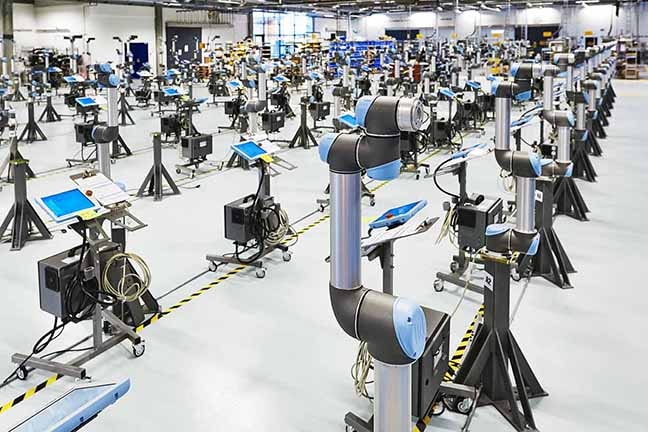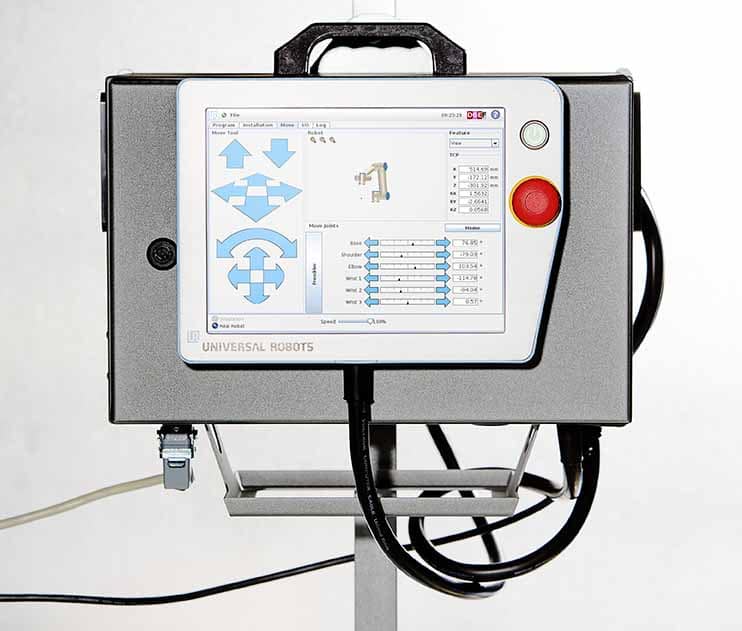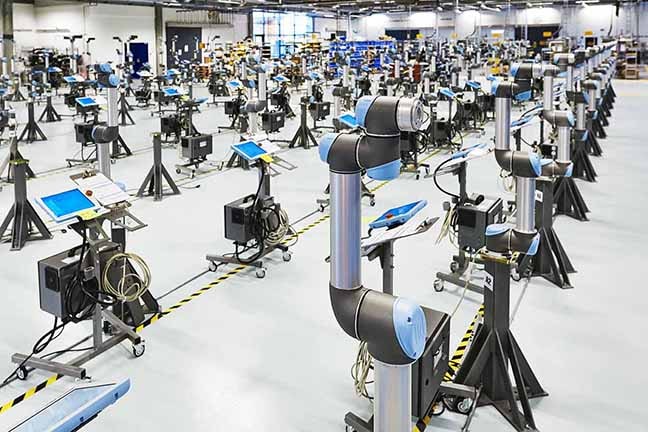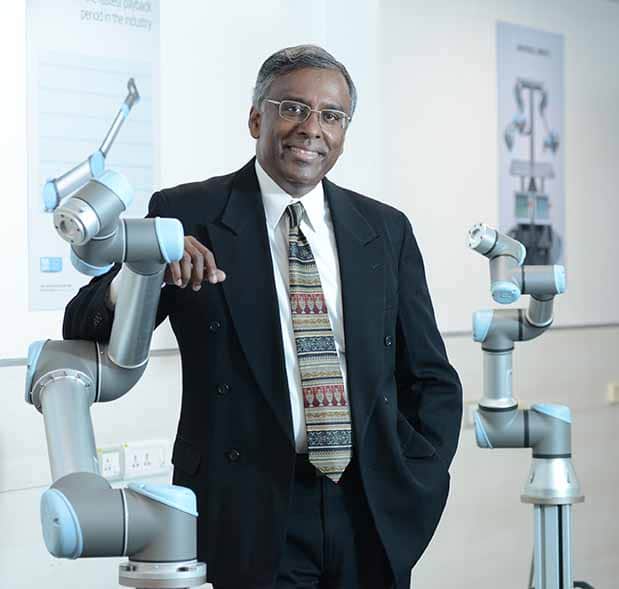Universal Robots is optimising cobot deployment on shopfloors to meet the emerging needs across the automotive value chain.
Story by: Deepti Thore
Automation with human collaboration has grown from strength to strength with more and more stakeholders of the automotive industry coming forward to pilot it. The Sars-CoV-2 might have only compelled the industry to leapfrog much before envisioned. With the total value chain brought to its knees and green shoots emerging only after growth came to a standstill, cobots are being projected as the go-to strategy to address the supply-side bottlenecks. On the supply-side, stakeholders, are turning to companies like Universal Robots to address the manpower crunch, the need to fire on all cylinders to boost productivity ahead of the festive season and to increase efficiencies on the whole. The availability of affordable and energy-efficient industrial cobots and rise in investment in R&D activities is no wonder claimed to have contributed to the growth of the global industrial cobot market.
Recording a sizeable jump of cobot sales, in India, Universal Robots (UR), in operation since 2011, claims to have deployed an estimated 46,000 cobots globally. It is claimed to command an over 50 per cent market share of the global cobot market according to Pradeep David, General Manager, South Asia at Universal Robots. “The market for cobots is growing at about 45 per cent. As the global lockdown impacted the manufacturing and supply chain globally we were quick to realise the rise in demand for cobots,” he stated. Claimed to have reinvented industrial robots with lightweight and flexible arms, UR according to David is banking on its vision to develop cobots on the concept of Human-Robot Collaboration (HRC) in a bid to offer true automation to manufacturers across the board. “We make robot technology accessible to manufacturers of all sizes and across industries, including but not limited to automotive, electronics, FMCG, and even Pharma,” he mentioned.
On-site
Cobots are visible in action on the shopfloors of Original Equipment Manufacturers (OEMs) like BMW and Bajaj Auto on the far upper end of the spectrum. David cited the Volkswagen charging station and cobots at Bajaj’s silent factory manufacturing the Chetak. A simple application can be set up in half a day, if not sooner claims David. Bajaj Auto Ltd., for instance, chose the UR cobots for their assembly lines. As the first company to adopt such cobots, the company is claimed to have improved its production capabilities and evolved its multi-modelling offerings.

The UR cobots are designed with a compact controller box measuring 475 mm in length, 423 mm in breadth and 268 mm in height with a relatively smaller footprint of 128-190 mm
 Drawing attention to the two-wheeler assembly lines being highly labour-intensive, spatially challenged and physically taxing with movements requiring high-end precision, explained David that the standardised automation solutions offered by UR coupled with the low payback period, flexibility, lightweight, cost-effectiveness, accuracy and safety are expected to work well for the latter. It took a three-month extensive pilot besides the reduced power consumption and retention of IP within the company to convince the OEM in the segment. Mercedes-Benz Research and Development India and Mahindra & Mahindra are the other automotive OEMs to install UR cobots at their plants, he added. UR robots as per David have also found relevance and takers in the Micro, Small and Medium Enterprises (MSMEs) universe. The company is claimed to have gained good traction with new adopters like Pune-based Shruti Engineers, for instance. The UR cobots deployed across this spectrum are all manufactured at the company headquarters, in Denmark.
Drawing attention to the two-wheeler assembly lines being highly labour-intensive, spatially challenged and physically taxing with movements requiring high-end precision, explained David that the standardised automation solutions offered by UR coupled with the low payback period, flexibility, lightweight, cost-effectiveness, accuracy and safety are expected to work well for the latter. It took a three-month extensive pilot besides the reduced power consumption and retention of IP within the company to convince the OEM in the segment. Mercedes-Benz Research and Development India and Mahindra & Mahindra are the other automotive OEMs to install UR cobots at their plants, he added. UR robots as per David have also found relevance and takers in the Micro, Small and Medium Enterprises (MSMEs) universe. The company is claimed to have gained good traction with new adopters like Pune-based Shruti Engineers, for instance. The UR cobots deployed across this spectrum are all manufactured at the company headquarters, in Denmark.
Wearing the badge of Rank 25 on the MIT list of top 50 smartest companies with pride, expressed David, UR is doing well to help the stakeholders of the automotive industry attain higher manufacturing efficiencies. It is doing so by enabling them to stay competitive in the long run even as the immediate focus remains on accelerating recovery. With over 650 employees, over 700 distributors and more than 30 international awards, UR, exclaimed David, is making its mark with next-generation shopfloor collaboration and automation solutions optimised for quick deployment.
Suited applications
In the UR e-Series range, the company offers a built-in force-torque sensor, 17 adjustable safety functions (including stopping time and stopping distance), with Cat. 3 PLd safety compliance. Catering to payload requirements from three to six kilogram, the UR3e, UR5e, UR10e, and UR16e, feature varying arm lengths or reaches, to suit machine tending, palletising, packaging, quality inspection, and pick and place operations. While mostly used in countries like the US or Europe, the e-series according to David is deployed by very few companies in India. Apart from these, UR’s standard range of cobots – UR3, UR5, and UR10 are well known. The new safety standard compliance with ISO TS15066 is expected to hold the company in good stead too.
Differentiators
Standardised for a host of payloads, at the core of the UR cobots is the End of Arm Tooling (EOAT) and programming capabilities, built-in. “We offer ease of setup and operations to those with no prior experience through the knowledge resources made freely available by Universal Robots Academy. This makes it a ‘Plug and Produce’ solution,” explained David. The Universal Robots+ platform of software and accessories are tested and certified to work seamlessly with UR cobots across inspection, palletising, and polishing requirements. The UR cobots are designed with a compact controller box measuring 475 mm in length, 423 mm in breadth and 268 mm in height with a relatively smaller footprint of 128-190 mm making it portable and suited to lean and agile production.
Created by third-party companies, these solutions are comprehensively tested by UR. The UR+ application kits combine multiple components with software designed on the UR+ platform to streamline deployments across popular job assignments like assembling, finishing, material handling, quality inspection and welding. UR+ components claimed David, automates nearly anything faster with certified plug-and-produce peripherals thus saving operators a lot of time.
Sans the need to run scheduled maintenance like a grease, oil or battery change as is the case with most robots, the UR cobots are offered with an ‘extended warranty’ of up to three years coupled with the initial 12-month warranty offered. “Our strategy of setting up site inspection closer to customers is aimed at ensuring ongoing and priority support,” mentioned David. On ‘on-demand’ assistance, David drew attention to the UR R&D centre at Odense in Denmark and Boston in the US, from which UR drives innovations to address existing and future automation requirements of customers and partners. Certified technical specialists from Denmark, for instance, offer on-demand training sessions to the company’s global clientele.
Self-reliant India
On contributing to the ‘Atmanirbhar Bharat’ movement, Pradeep urged Indian manufacturers to draw inspiration from the world’s leading manufacturers. He stressed on the need to switch to technologically advanced solutions like cobots if manufacturers were to attain global standards of production. “In a study from 2019, the International Federation of Robotics (IFR) found that the average number of robots per 10,000 employees is about 99, with Asia being the world’s largest industrial robot market,” he mentioned. “India falls at about four robots, 25 times behind the global average. Here the cumbersome, expensive and difficult to deploy nature of traditional robots have proved to be a big deterrent,” he quipped. True automation according to David is when humans only oversee the operations as is the case with cobots. Industry 5.0, stated David, can change the course of automation completely as it is all about highly skilled people and robots working collaboratively for creating individualised products, services and experiences. “Cobots will help manufacturers pair the unique and cognitive skills of labour with robots for heavy-lifting, consistency quality and round-the-clock exactitude or accuracy,” he opined.
Go-to-Market approach
UR according to David is especially focusing on SMEs reeling under the strict lockdown induced degrowth. Be it the unstable and fluctuating labour supply heightened by labour migration, limitations of a restricted shop floor layout, or compliance with social distancing norms laid down by the government. Offering ease of operations for the first time operators, opined David, SMEs could look at assigning the dull, dirty or dangerous to cobots with the workforce diverted to tasks requiring human ingenuity and dexterity. Citing the floor space utilisation flexibility, synonymous with cobots, he explained that there was scope for penetration in the segment given the capability of moving around cobots to different applications on different lines as per requirement. “It saves both time and money for manufacturers. Add to it, our cobots have advanced safety features, especially the e-series,” he claimed. Pradeep, however, advocated the need for customers to assess “application risk” to ensure the final safety assessment in order to be fully convinced of the UR proposition of optimised cobot deployment. ACI














Leave a Reply